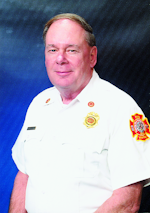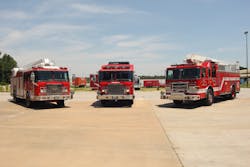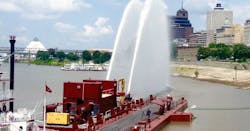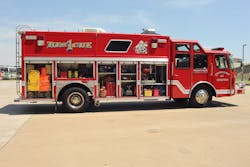Hazmat Studies: Memphis’ Evolution of Hazmat to All-Hazards Rescue
Memphis, TN, is located on the Mississippi River in the southwest corner of the state, covering an area of 324 square miles. The Memphis population is approximately 652,717, making it the largest city in Tennessee and the largest on the Mississippi River. If you include the entire metropolitan area, which encompasses cities and counties in Tennessee, Arkansas and Mississippi, the population jumps to 1,316,100.
Memphis Fire Department
Today's modern Memphis Fire Department is led by Director of Fire Services Gina Sweat, the first female director of the department.
The department employs 1,685 uniformed personnel operating from 57 stations. Housed in those stations are 56 engine companies and 21 truck companies, 34 ALS ambulance medic units, eight squads, six brush trucks, one collapse trailer and two decontamination trailers. In addition, Memphis has several specialized units, including three heavy rescues (squads), which handle hazmat response and all-hazards rescue, two Zumro fireboats and crash rescue equipment at the Memphis International Airport. The airport is the busiest air cargo hub in the world.
Fire companies in Memphis are composed of an officer, driver, firefighter and a firefighter-paramedic. Firefighters work a schedule of 24 on, 24 off, 24 on, 24 off, 24 on, followed by four days off.
Training for all disciplines in the fire department is conducted at the impressive Chester Anderson Fire Training Campus in Memphis, which was constructed in 2001. Chester Anderson was the director of the department at the time the center was built.
Memphis firefighters responded to 123,405 EMS calls and 21,621 fires in 2018.
Hazmat team history
All-Hazards Rescue (Special Operations) in the Memphis Fire Department began in the 1970s with the formation of two hazardous materials teams. Rope rescue was added in the 1980s, then structural collapse, confined space and trench rescue in 1997, and water rescue in 2007.
In 1995, Fire Squads 2 and 6 were hazmat-certified, and each covered approximately half of the city. Fire Squads evolved into today's Rescue Companies 1, 2 and 3. Rescue 1, a 1997 E-One, is located at Station 56 along with Engine 56, Truck 25 and Unit 26. Rescue 2, a 2000 E-One, is located at Station 36, which also houses Engine 36, a rescue boat and Unit 17. Rescue 3, a 2007 Pierce, is located at Station 27 with Engine 27, Unit 22 and a Zumro fireboat. Rescues 1, 2 and 3 are dedicated units.
All personnel who are assigned to rescue stations are trained to the Hazardous Materials Technician level. Firefighters throughout the rest of the city are trained to the Hazardous Materials Operations level. All-Hazards Rescue personnel receive cross-training on all types of rescue, not just hazardous materials. Initially, 132 hours of training is required for personnel for certification.
Approximately 30 hazmat personnel are on duty each shift with 130 technicians citywide. These numbers drop when the Tennessee Task Force 1 Urban Search & Rescue Team is activated. Task Force 1 is stationed in Memphis.
During 2018, the All-Hazards Units responded to 378 hazmat incidents. Hazmat response incidents include fuel spills, gas odors and leaks. If mutual aid is required, Shelby County Fire and Refinery firefighting crews are available.
Engine companies carry absorbent and dispersal materials (tow trucks carry absorbents) and respond to fuel spills of 10 gallons or less. Larger spills require hazmat team response. A warehouse of 55-gallon drums of foam is located at the training academy. Also, foam is deployed on the fire barge.
Hazmat exposures
Highway routes for hazardous materials include Interstates 40 and 55 and U.S. Highway 51. Railroads that operate in the Memphis area include the Burlington Northern Santa Fe and Canadian North. Barge traffic on the Mississippi often carry hazardous materials.
Fixed facility hazmat exposures include DuPont Chemical, Praxair, Drexel Chemical, USZINC, Valero Refinery, Cargill and numerous other chemical facilities within the city limits. Chemical exposures include solvents, fertilizers, hydrogen peroxide, anhydrous ammonia, cyanide, sulfuric acid fuming, sodium hydroxide, propane, chlorine and pesticides.
The greatest concentration of hazmat exposures in the city is located on President’s Island, where there is a pipeline on the eastern shore of the Mississippi River. The island is also considered the largest commercial and manufacturing area in the South. President’s Island is part of the International Port of Memphis.
This port is the second-largest inland port on the shallow draft portion of the Mississippi River, and the fourth largest inland port in the United States. The International Port of Memphis covers the Tennessee and Arkansas sides of the Mississippi River from river mile 725 to mile 740. Within this 15-mile reach, there are 68 water-fronted facilities, 37 of which are terminal facilities moving products such as petroleum, tar, asphalt, cement, steel, coal, salt, fertilizers, rock and gravel, and grains.
Pro-Serve fire and hazmat incident
In August 2006, the Memphis Fire Department faced an extraordinarily complex hazmat incident that was further complicated by fire. Three chemical manufacturing facilities were involved that produced and stored a wide range of hazardous chemicals.
On Aug. 2, 2006, at 1:47 p.m., Memphis firefighters were dispatched to a fire next to Valley Products at 384 East Brooks Road. First-arriving companies radioed that there was smoke showing at the Pro-Serve facility at 400 E. Brooks Road. Size-up determined that there had been a small fire involving a pallet of sodium chlorate and a forklift that had been extinguished by the sprinkler system before firefighters arrived. Employees at Pro-Serve had been exposed to the smoke, were decontaminated and given medical evaluations by fire personnel on scene. Cleanup was handled by Pro-Serve.
Command became aware that employees at nearby Bucyrus International had also possibly been exposed to the smoke. Because of limited exposure, Bucyrus employees refused decontamination, medical treatment, and transport. Both incidents were declared stabilized at 3:28 p.m.
On Aug. 4, 2006, at 4:07 p.m., the Memphis 9-1-1 call center received multiple reports of an explosion and heavy smoke in the area of Brooks Road and Third Street. It was initially dispatched as a hazmat incident.
First-in companies reported a fire and heavy smoke at the Pro-Serve building. The first-arriving engine company advanced a 2½-inch attack line into the building. Division 1 arrived on scene a short time later and assumed Brooks Road Command. A second alarm was requested at that time. Command decided to cease all offensive operations until more information could be gathered about chemicals inside. A hazmat branch was established.
Runoff was reported to have entered and contaminated Nonconnah Creek.
Hazmat Operations decided to recommend extinguishment of the fire, and it had been knocked down at 8:29 p.m. The incident was declared stabilized at 9:07 p.m.
As the scene was downgraded, a fire ruins detail schedule was established. Brooks Road Command was transferred several times. It was discovered that IBC Manufacturing at 416 E. Brooks Road had also been involved in the incident. Due to multiple unknown chemicals stored at that location and the unavailability of IBC personnel, Brooks Road Command gave orders not to enter the structure.
On Aug. 5, 2006, at 2:55 a.m., Brooks Road Command requested a hazmat assignment and Division 1. One minute later, a second alarm was requested. Brooks Road Command reported fire coming through the roof as well as explosions occurring in what was eventually determined to be the IBC warehouse. Due to the unknown nature of the products, the amount of fire involvement, and environmental concerns from run-off, Brooks Road Command made the decision to let the building free-burn. Efforts were concentrated on isolating the area, evacuating the citizens, and monitoring the air.
At daylight, aerial surveillance was conducted via helicopter, material safety data sheets (MSDS) were obtained and hazmat teams conducted recon. The intensity of the fire had subsided, and the decision was made to attack the remaining fire that was in the IBC tank farm using limited water and AFFF.
At 3:54 p.m., the fire was reported knocked down. The incident was downgraded, and a ruins detail was scheduled including hazmat team personnel.
On Aug. 9, 2006, at 4:42 p.m., fire companies were again dispatched to Pro-Serve. Initial-arriving companies reported light smoke coming from the tower area. United States Environmental Services (USES) and the Center for Toxicology and Environmental Health (CTEH) had been on scene since the earlier incident on Aug. 5, conducting cleanup and air monitoring operations. They reported that the material on fire was not water-reactive. The company officer made the decision to attack the fire with a 2½-inch hoseline.
Hazmat had been dispatched and was conducting air monitoring. Brooks Road Command was set up at Brooks and South Center Road and a second alarm was requested at 5:04 p.m. Command ordered companies out of the building until more product information was obtained. Hazmat personnel used unmanned monitors to extinguish the remaining fire. The fire was reported knocked down at 8:04 p.m. and a ruins detail was set up and a fire department presence was maintained until Sept. 1, 2006.
For more
The Memphis Fire Department has a rich history, and the hazmat team was one of the early pioneers in hazmat response development. Its extensive and diverse hazmat exposures provide daily challenges for the current hazmat team. For questions and additional information, contact Chief Johnny Lock at [email protected] or Carl Schweers at [email protected].

Robert Burke
Robert Burke, who is a hazardous materials and fire protection consultant and who served as a Firehouse contributing editor, is a Certified Fire Protection Specialist (CFSP), Fire Inspector II, Fire Inspector III, Fire Investigator and Hazardous Materials Specialist. He has served on state and county hazmat teams. Burke is the author of the textbooks "Hazardous Materials Chemistry for Emergency Responders," "Counter-Terrorism for Emergency Responders," "Fire Protection: Systems and Response," "Hazmat Teams Across America" and "Hazmatology: The Science of Hazardous Materials."










